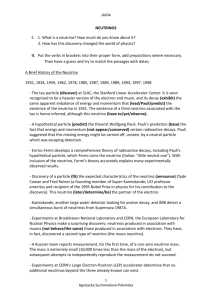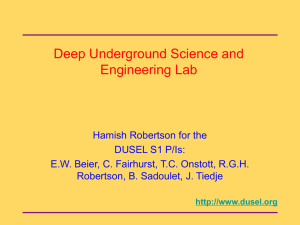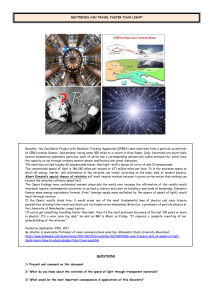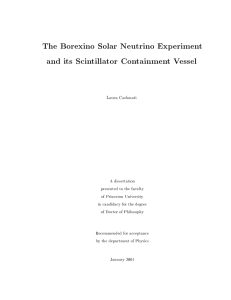First Direct Detection of Solar 7-Be Neutrinos and Prospects of Low
advertisement
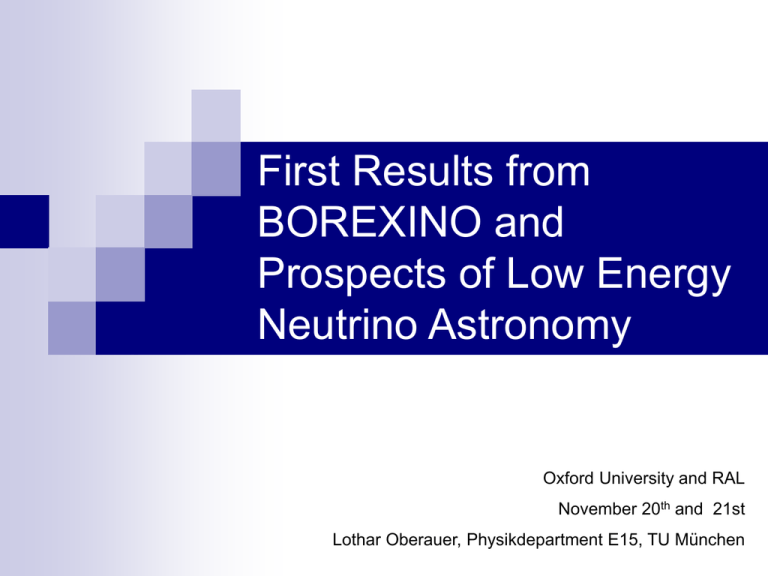
First Results from BOREXINO and Prospects of Low Energy Neutrino Astronomy Oxford University and RAL November 20th and 21st Lothar Oberauer, Physikdepartment E15, TU München Charge Interactions Neutrinos as probes ? 0 w w,e -1 w,e,s +2/3 -1/3 Neutrinos undergo only weak interactions: No deflection in electric or magnetic fields, extremely penetrating => n‘s are perfect carriers of information from the centers of astrophysical objects Neutrino Mixing Flavor eigenstates n e 1 0 n 0 c23 n 0 s 23 = Mixing matrix x Mass eigenstates i 0 c13 0 s13e c12 s12 0 n 1 s23 0 1 0 s12 c12 0 n 2 c23 s13ei 0 c13 0 0 1 n 3 2 mixing angles are measured: Q12 ~ 340 Q23 ~ 450 m23 – m22 ~ 2.6 x 10-3 eV2 atmospheric n and accelerator n exp. m22 – m21 ~ 8 x 10-5 eV2 solar and reactor n experiments Open: Q13 ? CP violating phase ? Absolute mass scale (mn < 2.2 eV) ? Mass hierarchy ? Neutrino oscillations (i.e. flavor transitions) and matter depending effects May complicate interpretation of astrophysical processes Access to n intrinsic properties not available in laboratory experiments ! Low energy n astronomy Intrinsic n parameters (particle physics) Natural Neutrino Sources (experimentally verified) Sun (since 1970) Earth (since 2005) Atmosphere (since ~1990) Supernovae (1987) Natural Neutrino Sources (not yet verified) Big Bang Active galactic nuclei ? Supernovae remnants ?, Gamma ray bursts ?, Supernovae relic neutrinos ?... Energy Spectra of Astrophysical Neutrinos low energy ~ 1 GeV ? Thermal sources Non-thermal sources high energy The dominating solar pp - cycle H. Bethe W. Fowler pp - 1 pp -2 pp -3 The sub-dominant solar CNO - cycle …dominates in stars with more mass as our sun… =>Large astrophysical relevance “bottle-neck” reaction slower than expected (LUNA result) Solar CNO-n prediction lowered by factor ~ 2 ! Impact on age of globular clusters Solar Neutrinos 4 p He 2e 2n e 26.7 MeV 4 GALLEX GNO SAGE Integral whole spectrum BOREXINO Since august 2007 7-Be neutrinos no spectral information Neutrino Energy in MeV SuperK, SNO Directional information History of solar neutrino experiments at 2007 All experiments were successful •Discovery of neutrino oscillations •Probing thermal fusion reactions Oscillations and matter effects Oscillation length ~ 102 km => oscillation smeared out and non-coherent Effective ne mass (due to forward scattering on electrons) is enhanced by a potential A A ~ GFNeE2 => for E > 1 MeV matter effect dominates and leads to an enhanced ne suppression for those energies… Missing info here before BOREXINO Now additional Improvement on uncertainty on pp-ne flux 1 Vaccum regime 10 MeV Matter regime BOREXINO Neutrino electron scattering n e > n e Liquid scintillator technology (~300t): Low energy threshold (~60 keV) Good energy resolution (~4.5% @ 1 MeV) Sensitivity on sub-MeV neutrinos Online since May 16th, 2007 Borexino Collaboration Genova Milano Princeton University APC Paris Perugia Dubna JINR (Russia) Kurchatov Institute (Russia) Virginia Tech. University Munich (Germany) Jagiellonian U. Cracow (Poland) Heidelberg (Germany) BOREXINO in the Italian Gran Sasso Underground Laboratory in the mountains of Abruzzo, Italy, ~120 km from Rome Laboratori Nazionali del Gran Sasso LNGS External Labs Shielding ~3500 m.w.e Borexino Detector and Plants BOREXINO Detector layout Scintillator: 270 t PC+PPO in a 150 m thick nylon vessel Nylon vessels: Inner: 4.25 m Outer: 5.50 m Stainless Steel Sphere: 2212 PMTs + concentrators 1350 m3 Water Tank: g and n shield water Č detector 208 PMTs in water 2100 m3 Excellent shielding of external background Carbon steel plates Increasing purity from outside to the central region The ideal electron recoil spectrum due to solar neutrino scattering pp 7-Be CNO, pep 8B Arbitrary units Energy Spectrum (no cuts) 14C dominates below 200 KeV 210Po NOT in eq. with 210Pb Mainly external gs and s Photoelectrons Statistics of this plot: ~ 1 day Problem: muons going through the buffer may create pulses in the neutrino energy window via Cherenkov light Muon cuts 350 PMS without light concentrators Npe (no-cone) / Npe (all) is higher for muons Sensitive cut (“Deutschcut”) on muons using the Inner Detector Additional cuts on pulse shape applicable Neutrino candidates muons Outer Detector efficiency OD-efficiency ~ 99% Total muon rejection power (incl. cuts ID) ~ 99.99% Preliminary, exact numbers require more detailed studies muons Distribution of events without OD-muon flag Fiducial volume cut Rejection of external background (mostly gammas) R < 3.3 m (100 t nominal mass) Radial distribution z vs Rc scatter plot R2 gauss FV R x2 y 2 z 2 Rc x 2 y 2 Spectrum after muon and fiducial volume cuts 210Po 14C (only, not in eq. with 210Pb!) 85Kr+7Be n 11C Last cut: 214Bi-214Po and Rn daughters removal 238U 232Th and 212Bi-212Po = 432.8 ns 212Bi b a 212Po 208Pb ~800 KeV eq. 2.25 MeV = 236 s 214Bi b 3.2 MeV a 214Po 210Pb ~700 KeV eq. 232Th Events are mainly in the south vessel surface (probably particulate) 212Bi-212Po 214Bi-214Po Only 3 bulk candidates (47.4d) 238U: < 2. 10-17 g/g 232Th: < 1. 10-17 g/g a/b Separation in BOREXINO a particles Full separation at high energy b particles ns 250-260 pe; near the 210Po peak 2 gaussians fit a/b Gatti parameter signal: fit without a/b subtraction Po peak not included in this fit 7Be 210 Strategy: Fit the shoulder region only Area between 14C end point and 210Po peak to limit 85Kr content pep neutrinos fixed at SSM-LMA value 7Be CNO + 210Bi Fit components: 7Be n 85Kr CNO+210Bi combined Light yield left free These bins used to limit 85Kr content in fit n 85Kr signal: fit a/b subtraction of 210Po peak 7Be 210Po background is subtracted: For each energy bin, a fit to the a/b Gatti variable is done with two gaussians From the fit result, the number of a particles in that bin is determined This number is subtracted The resulting spectrum is fitted in the energy range between 270 and 800keV The two analysis yield fully compatible results BOREXINO 1st result (astro-ph 0708.2251v2) Scattering rate of 7Be solar n on electrons 7Be n Rate: 47 ± 7STAT ± 12SYS c/d/100 t BOREXINO and n-Oscillations No oscillation hypothesis 75 ± 4 c/100t/d Oscillation (so-called Large Mixing Solution) 49 ± 4 c/100t/d BOREXINO experimental result 47 ± 7stat ± 12sys c/100t/d Survival probability Pee for solar ne Pee Gallium experiments: 8B and 7Be neutrinos subtracted ! 1.0 0.8 0.63 ± 0.19 0.6 BOREXINO Transition of vacuum to matter dominated n oscillations predicted by MSW-effect It implies m2 > m1 0.4 0.34 ± 0.04 SNO, SuperKamiokande 0.2 < 0.44 0.86 5.5 - 15 Energy in MeV Prospects of BOREXINO Improvement of systematical uncertainty up to now it is dominated by uncertainty on fiducial volume => calibrations 7Be flux measurement with 10% uncertainty => 1% accuracy for pp-neutrinos ! (BOREXINO + LMA parameters + solar luminosity) Theoretical uncertainty on pp-neutrino flux ~ 1% => high precision test of thermal fusion processes Aim to measure CNO and pep-neutrinos, perhaps ppneutrinos and 8B-neutrinos below 5.5 MeV Additional features: Geo neutrinos & reactor neutrinos & Supernova neutrinos (~100 events) for a galactic SN type II CNO and pep Neutrinos Problem: muon induced 11C nuclei > 11B e+ ne (Q = 1.0 MeV, T1/2=20.4min) 11C Aim: tag via 3-fold delayed coincidence , n (~ms) reconstruct position of n-capture veto region around this position for ~ 1 hour. Required rejection factor ~ 10 track reconstruction LAGUNA Large Apparatus for Grand Unification and Neutrino Astronomy Future Observatory for n-Astronomy at low energies Search for proton decay (GUT) Detector for “long-baseline” experiments Astrophysics Details of a gravitational collapse (Supernova Neutrinos) Studies of star formation in former epochs of the universe („Diffuse Supernovae Neutrinos Background“ DSNB) High precision studies of thermonuclear fusion processes (Solar Neutrinos) Test of geophysical models (“Geoneutrinos”) LAGUNA Large Apparatus for Grand Unification and Neutrino Astrophysics LENA liquid scintillator 13,500 PMs for 50 kt target Wasser Čerenkov muon veto coordinated F&E “Design Study” European Collaboration, FP7 Proposal APPEC Roadmap MEMPHYS GLACIER Water Čerenkov liquid-Argon 500 kt target in 3 tanks, 3x 81,000 PMs 100 kt target, 20m driftlength, 28,000 PMs foor Čerenkov- und szintillation LENA: Diffuse SN Background ne + p -> e+ + n Delayed coincidence Spectral information Event rate depends on -Supernova type II rates -Supernova model Range: 20 to 220 / 10 y Background: ~ 1 per year M. Wurm et al., Phys. Rev D 75 (2007) 023007 Supernova neutrino luminosity (rough sketch) Relative size of the different luminosities is not well known: it depends on uncertainties of the explosion mechanism and the equation of state of hot neutron star matter. Info on all neutrino flavors and energies desired! T. Janka, MPA Galactic Supernova neutrino burst in LENA Event rates in LENA SN Neutrino predicted rates vary with … - distance and progenitor mass (here: 10 kpc, 8 solar masses) - the used SN neutrino model (mean energies, pinching) - neutrino physics (value of q13, mass hierarchy) variation: 10-19 x103 ev @ 10kpc Aims - physics of the core-collapse (neutronisation burst, n cooling …) - determine neutrino parameters - look for matter oscillation effects (envelope, shock wave, Earth) Matter effects in the Earth •mass hierarchy •theta_13 Matter effects in the SN: •mass hierarchy and theta_13 •time development of the shock wave? Separation of SN models ? Yes, independent from oscillation model ! neutral current reactions in LENA e.g. TBP KRJ LL 12C: 700 950 2100 n p: 1500 2150 5750 for 8 solar mass progenitor and 10 kpc distance Conclusions Low Energy Neutrino Astronomy is very successful (Borexino direct observation of sub-MeV neutrinos) Strong impact on questions in particleand astrophysics New technologies (photo-sensors, extremely low level background…) Strong European groups



